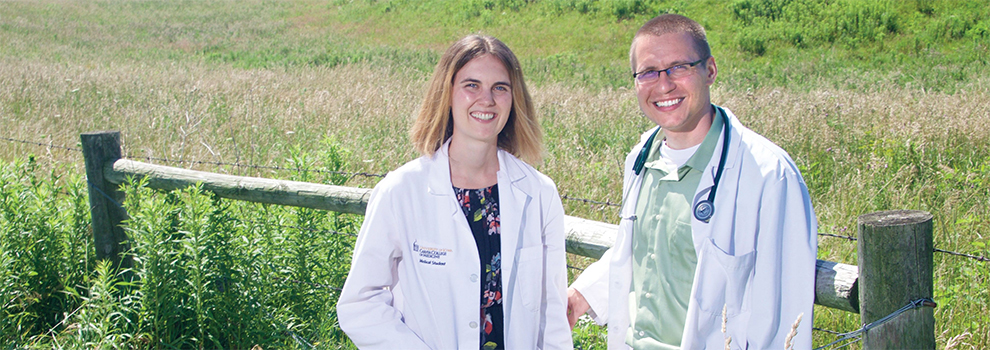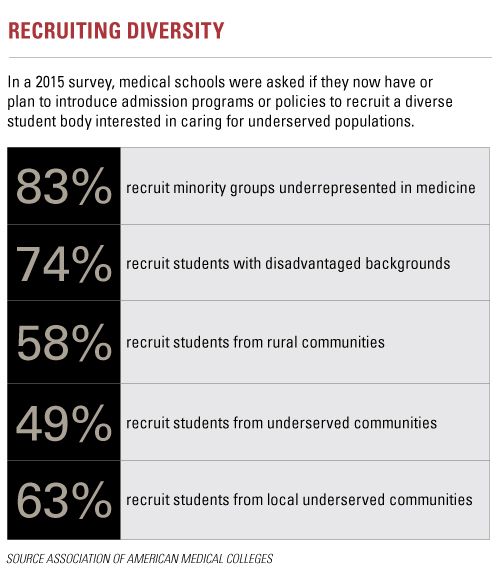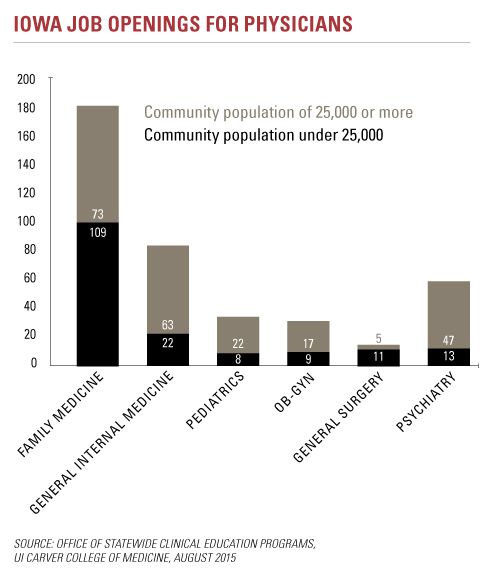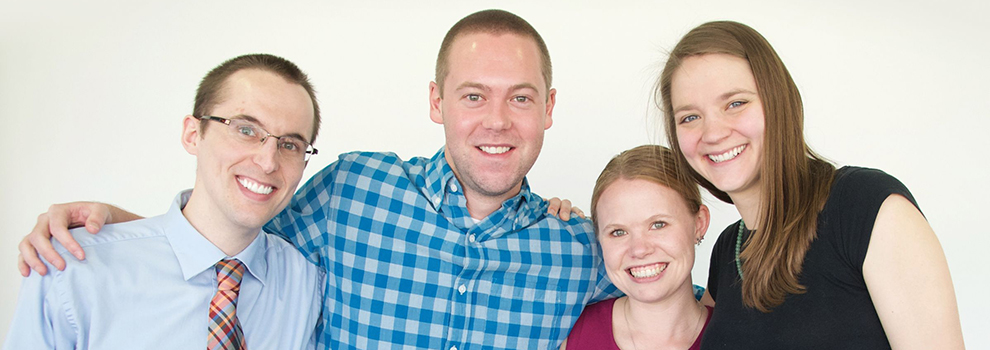Greener Pastures: Needing rural doctors, Iowa grows its own (and pays for the training)

In a few years, Shea and Michael Jorgensen will be top recruits for Iowa—not as blue-chip athletes for the Hawkeyes but as doctors for a small community.
The couple are fourth-year students in the University of Iowa Carver College of Medicine, preparing to interview for residencies where they will do their specialty training. Ultimately, they want to practice in rural Iowa, she in psychiatry and he in family medicine.
“I grew up in a super-small town of 250 people near Mason City. I like the connection doctors have within a small community. You do a breadth of practice but you really get to know your patients, and you can be active in the community outside of medicine as well,” says Shea Jorgensen, from Grafton. Michael Jorgensen is from Clinton.

Residents of small Iowa communities—particularly physicians nearing retirement—should cheer her words. She has spent the past three years immersed in the college’s Rural Iowa Scholars Program (CRISP), working alongside physician mentors in Decorah, Rockwell, and Muscatine; learning about rural health issues in an agricultural medicine collaboration with the UI colleges of Public Health and Nursing; and networking with UI medical students and physicians across the state who favor a small-town practice. She knows what she’s getting into, the rewards and the challenges. If she practices for at least five years in a small community after her residency, Shea Jorgensen is eligible for significant funds to repay student loans.
“It’s perfect,” she says of CRISP. “I could get paid for doing what I was always planning to do, plus get additional training and be with students who have similar interests.”
The Association of American Medical Colleges (AAMC) predicts a shortage of 61,700 to 94,700 physicians across the U.S. by 2025, with some of the hardest hit areas in rural communities where the population tends to be older and in need of the most care. More than half of U.S. medical schools have ramped up efforts to recruit students from rural communities who will become physicians in these areas. The UI Carver College of Medicine launched CRISP in 2012 and graduated the first four doctors from the program this year.
“It’s clear that we need to grow our own future doctors, rather than try to recruit them from Florida, New York, or California. If you have somebody from Iowa who knows they want to stay, then invest in that, because your investment pays off when they do stay in Iowa,” says Michael Maharry (’96 MD, ’99 R), clinical associate professor of family medicine with UI Health Care-Muscatine and director of CRISP.
“It’s great that this program has started to generate those returns and we’re going to have providers ready in a few short years to spend their careers here,” Maharry says.
Rural Iowa’s challenges
Whitney Kaefring (’16 MD) intends to practice family medicine in an Iowa community of fewer than 26,000 people located more than 20 miles from a city with a population of at least 50,000. Those are the rules she must follow for at least five years to receive a student loan repayment award of up to $200,000 from the Rural Iowa Primary Care Loan Repayment Program, which is supported by state appropriations and private donations. She qualified for the state program after securing an in-state residency at UI Hospitals and Clinics.
CRISP, which is funded by the UI Carver College of Medicine, offers a loan repayment incentive as well—up to $100,000 to students in CRISP who become physicians in small-town Iowa after completing a residency in family medicine, general surgery, internal medicine, pediatrics, or psychiatry. While the state-funded loan repayment program requires an in-state residency training program, CRISP allows out-of-state residencies.
In 2016, 27 UI Carver College of Medicine graduates who matched to appropriate in-state residencies could apply for the Rural Iowa Primary Care Loan Repayment Program, which also is available to graduates of Des Moines University College of Osteopathic Medicine. Five of the 27 UI graduates applied.
“Some of our graduates don’t want to commit to the population rules. They know they want to be in Davenport, Iowa City, or Des Moines. The ones that want to be within 20 miles of a city like that choose not to apply,” says Linda Bissell, the college’s director of financial services.
The challenges of rural practice are both professional and personal. A small practice may lack imaging equipment or other technology, as well as convenient access to specialists for their patients. High patient volumes and complicated cases—due to the typically older population or because patients delay care when they must travel farther or wait longer for appointments—often contribute to physician burnout. Aside from patient care, physicians are responsible for the business aspects of a small practice, including hiring nurses and staff, ordering vaccines and supplies, and managing insurance claims and other paperwork.
Smaller communities tend to have fewer social services for elderly and low-income residents, which can place a greater burden on the local doctor to identify resources to help patients maintain their health. And then there’s the stereotype: What is there to do in a small town?
“Living in Iowa City, I realize why people don’t want to move to a small town. It’s nice to have all the amenities of Iowa City,” Shea Jorgensen says. “I can go to a concert. I get violin lessons now because I can. Then you realize that by moving to a small town, you won’t have all of these options.”
While both Jorgensens could have careers in the same small community, that’s less likely for Kaefring and her husband, Max Liu, a student in the dual-degree Medical Scientist Training Program at the UI. “My husband is in the MD/PhD program, so he will need an academic medical center for his future work. Our options probably will involve commuting for both of us,” says Kaefring, who is from Solon and participated in CRISP. Still, she is committed to rural practice.
“My passion is rural medicine. I come from a long line of teachers, so I would do rural medicine whether I made a doctor’s salary or a teacher’s salary, but that’s not true for all people,” she says.
Rural Iowa’s attractions
Newly hooded doctors left the UI Carver College of Medicine with student loan debt averaging $151,500 in 2015, the latest year for which official numbers are available. Some had debt topping $300,000.
“It’s like they come out with a mortgage and they don’t even have a house yet,” Maharry says.
Loan repayment incentives can be a huge draw in a rural region without mountain vistas, big-time entertainment options, or salaries to lure young professionals away from major metropolitan areas. Statistics show that 67 percent of UI Carver College of Medicine graduates who have done their primary care residency training in Iowa have chosen to stay for their practice, says Greg Nelson, assistant dean for clinical education programs in the UI Carver College of Medicine.
 Nelson chairs a Primary Care Task Force funded by a three-year, $1 million state grant that is developing strategies to increase the number of residents who choose rural Iowa communities for their practice in family medicine and psychiatry, two of the three specialties with the highest market demand. Task force members include UI Carver College of Medicine trainees, faculty physicians, and the departmental leaders in both disciplines.
Nelson chairs a Primary Care Task Force funded by a three-year, $1 million state grant that is developing strategies to increase the number of residents who choose rural Iowa communities for their practice in family medicine and psychiatry, two of the three specialties with the highest market demand. Task force members include UI Carver College of Medicine trainees, faculty physicians, and the departmental leaders in both disciplines.
The Office of Statewide Clinical Education Programs, which Nelson leads, maintains up-to-date directories listing job openings across the state for physicians in six specialties (family medicine, general internal medicine, pediatrics, general surgery, psychiatry, and obstetrics-gynecology), nurse practitioners, and physician assistants. These opportunities directories are distributed to all Iowa-based residents in the six specialties.
There were 399 openings for physicians in the six disciplines by the end of August 2015, the most recent date for comprehensive data. If AAMC predictions are correct, those numbers will grow, due in large part to an aging U.S. population. Between 2014 and 2025, the population of adults age 65 and older will increase 41 percent, while the population under age 18 will grow by 5 percent.
“New physicians can go wherever they want in America,” Maharry says. “Sometimes our graduating students want to spread their wings and see what it’s like in Denver, Seattle, or Miami Beach because they can—every one of those locations is looking for doctors, too.”
But UI medical student Shea Jorgensen is determined to practice in Iowa.
“When I originally applied (for CRISP), I never thought that my mind would stray about practicing in a small community, since I grew up in a small community. Having a rural emphasis in my training has helped to keep me focused on that,” she says.
“We even have chickens in our backyard in Iowa City,” she says. “I’m just meant to live on a farm or in a small town.”
Curriculum with a rural focus

The first graduates of the UI Carver College of Medicine Rural Iowa Scholars Program: Kale Manuel, Jesse Van Maanen, Whitney Kaefring, and Elizabeth Dupic.
The University of Iowa Carver College of Medicine Rural Iowa Scholars Program (CRISP) embeds rural elements in the medical curriculum to prepare doctors for future careers in smaller communities.
Each year, CRISP accepts four students from the 152 who are admitted into the college. Selection for the program is competitive and based on previous experience with rural life, a commitment to practice medicine in Iowa, an understanding of the roles and responsibilities of a rural physician, and personal characteristics important in the practice of rural medicine.
CRISP students follow the same curriculum as their classmates, but their experiential opportunities have a rural emphasis, including rotations at rural sites. During the summer following their first year, CRISP students participate in the Medical Education in Community Orientation program at a community hospital in rural Iowa. They observe and work with physicians in various specialties and are immersed in the community for four to 12 weeks.
Each CRISP student is paired with a physician mentor who practices in a small community and can offer advice and guidance during their four years of training. The mentor supervises work on a capstone research project required to complete the program. Students gain insight from other rural physicians who present their stories through a speaker series organized by the college’s Rural Medicine Interest Group.
The first four students to complete CRISP graduated in May. After they complete their residencies, if they establish their practices in eligible Iowa communities—population under 26,000, more than 20 miles from a city with a population of at least 50,000—they will be eligible for student loan repayment programs.
CRISP students in the Class of 2016 are:
- Elizabeth Dupic, from Clarion, Iowa: Family medicine residency at Broadlawns Medical Center, Des Moines
- Whitney Kaefring, from Solon, Iowa: Family medicine residency at UI Hospitals and Clinics
- Kale Manuel, from Clarinda, Iowa: Psychiatry residency at University of Michigan Hospitals, Ann Arbor
- Jesse Van Maanen, from Leighton, Iowa: General surgery residency at University of South Dakota School of Medicine, Sioux Falls
This article originally appeared in the Summer 2016 edition of Medicine Iowa and was recently mentioned in U.S. News & World Report's article, "Consider a Career in Rural Medicine."